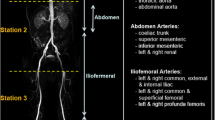Abstract
The aim of this study was to create a scoring system for whole-body magnetic resonance angiography (WBMRA) that allows estimation of atherosclerotic induced luminal narrowing, and determine whether the traditional cardiovascular (CV) risk factors included in the Framingham risk score (FRS) were related to this total atherosclerotic score (TAS) in an elderly population. A group of 306 subjects, aged 70, were recruited from the general population and underwent WBMRA in a 1.5-T scanner. Three-dimensional sequences were acquired after administration of one i.v. injection of 40 ml gadodiamide. The arterial tree was divided into five territories (carotid, aorta, renal, upper and lower leg) comprising 26 vessel segments, and assessed according to its degree of stenosis or occlusion. FRS correlated to TAS (r = 0.30, P < 0.0001), as well as to the atherosclerotic score for the five individual territories. Of the parameters included in the FRS, male gender (P < 0.0001), systolic blood pressure (P = 0.0002), cigarette pack-years (P = 0.0008) and HDL cholesterol (P = 0.008) contributed to the significance. A scoring system for WBMRA was created. The significant relation towards traditional CV risk factors indicates that the proposed scoring system could be of value for assessing atherosclerotically induced luminal narrowing.



Similar content being viewed by others
References
De Backer G, Ambrosioni E, Borch-Johnsen K et al (2004) European guidelines on cardiovascular disease prevention in clinical practice. Third Joint Task Force Of European and other societies on cardiovascular disease prevention in clinical practice (constituted by representatives of eight societies and by invited experts). Arch Mal Coeur Vaiss 97:1019–1030
Wilson PW, D’Agostino RB, Levy D, Belanger AM, Silbershatz H, Kannel WB (1998) Prediction of coronary heart disease using risk factor categories. Circulation 97:1837–1847
Hansen T, Wikstrom J, Johansson LO, Lind L, Ahlstrom H (2007) The prevalence and quantification of atherosclerosis in an elderly population assessed by whole-body magnetic resonance angiography. Arterioscler Thromb Vasc Biol 27:649–654
Brauck K, Breuckmann F, Barkhausen J, Ladd S (2006) Concomitant atherosclerotic changes in whole-body MR-Angiography and coronary calcium deposit in patients with catheter-staged coronary artery disease. In: Proc ISMRM, Seattle, USA, 6–12 May 2006, Abstract no. 1965
Goyen M, Herborn CU, Kroger K, Ruehm SG, Debatin JF (2006) Total-body 3D magnetic resonance angiography influences the management of patients with peripheral arterial occlusive disease. Eur Radiol 16:685–691
Fenchel M, Requardt M, Tomaschko K et al (2005) Whole-body MR angiography using a novel 32-receiving-channel MR system with surface coil technology: first clinical experience. J Magn Reson Imaging 21:596–603
Ruehm SG, Goehde SC, Goyen M (2004) Whole body MR angiography screening. Int J Cardiovasc Imaging 20:587–591
Herborn CU, Goyen M, Quick HH et al (2004) Whole-body 3D MR angiography of patients with peripheral arterial occlusive disease. AJR Am J Roentgenol 182:1427–1434
Hansen T, Wikstrom J, Eriksson MO et al (2006) Whole-body magnetic resonance angiography of patients using a standard clinical scanner. Eur Radiol 16:147–153
Lind L, Fors N, Hall J, Marttala K, Stenborg A (2005) A comparison of three different methods to evaluate endothelium-dependent vasodilation in the elderly: the Prospective Investigation of the Vasculature in Uppsala Seniors (PIVUS) study. Arterioscler Thromb Vasc Biol 25:2368–2375
Simon A, Giral P, Levenson J (1995) Extracoronary atherosclerotic plaque at multiple sites and total coronary calcification deposit in asymptomatic men. Association with coronary risk profile. Circulation 92:1414–1421
Budoff MJ, Achenbach S, Blumenthal RS et al (2006) Assessment of coronary artery disease by cardiac computed tomography: a scientific statement from the American Heart Association Committee on Cardiovascular Imaging and Intervention, Council on Cardiovascular Radiology and Intervention, and Committee on Cardiac Imaging, Council on Clinical Cardiology. Circulation 114:1761–1791
Cai JM, Hatsukami TS, Ferguson MS, Small R, Polissar NL, Yuan C (2002) Classification of human carotid atherosclerotic lesions with in vivo multicontrast magnetic resonance imaging. Circulation 106:1368–1373
Fenchel M, Scheule AM, Stauder NI et al (2006) Atherosclerotic disease: whole-body cardiovascular imaging with MR system with 32 receiver channels and total-body surface coil technology—initial clinical results. Radiology 238:280–291
Goehde SC, Hunold P, Vogt FM et al (2005) Full-body cardiovascular and tumor MRI for early detection of disease: feasibility and initial experience in 298 subjects. AJR Am J Roentgenol 184:598–611
Lin J, Chen B, Wang JH, Zeng MS, Wang YX (2006) Whole-body three-dimensional contrast-enhanced magnetic resonance (MR) angiography with parallel imaging techniques on a multichannel MR system for the detection of various systemic arterial diseases. Heart Vessels 21:395–398
Rigatelli G, Roncon L, Bedendo E et al (2005) Concomitant peripheral vascular and coronary artery disease: a new dimension for the global endovascular specialist? Clin Cardiol 28:231–235
Glagov S, Weisenberg E, Zarins CK, Stankunavicius R, Kolettis GJ (1987) Compensatory enlargement of human atherosclerotic coronary arteries. N Engl J Med 316:1371–1375
Pasterkamp G, Schoneveld AH, van Wolferen W et al (1997) The impact of atherosclerotic arterial remodeling on percentage of luminal stenosis varies widely within the arterial system. A postmortem study. Arterioscler Thromb Vasc Biol 17:3057–3063
Acknowledgements
We wish to thank the Swedish Scientific Council for financial support (grant no. VR-K2006-71X-06676-24-3) and GE Healthcare for providing gadodiamide (Omniscan). AstraZeneca provided financial support to Lind L for the PIVUS study.
Author information
Authors and Affiliations
Corresponding author
Rights and permissions
About this article
Cite this article
Hansen, T., Ahlström, H., Wikström, J. et al. A total atherosclerotic score for whole-body MRA and its relation to traditional cardiovascular risk factors. Eur Radiol 18, 1174–1180 (2008). https://doi.org/10.1007/s00330-008-0864-6
Received:
Revised:
Accepted:
Published:
Issue Date:
DOI: https://doi.org/10.1007/s00330-008-0864-6




